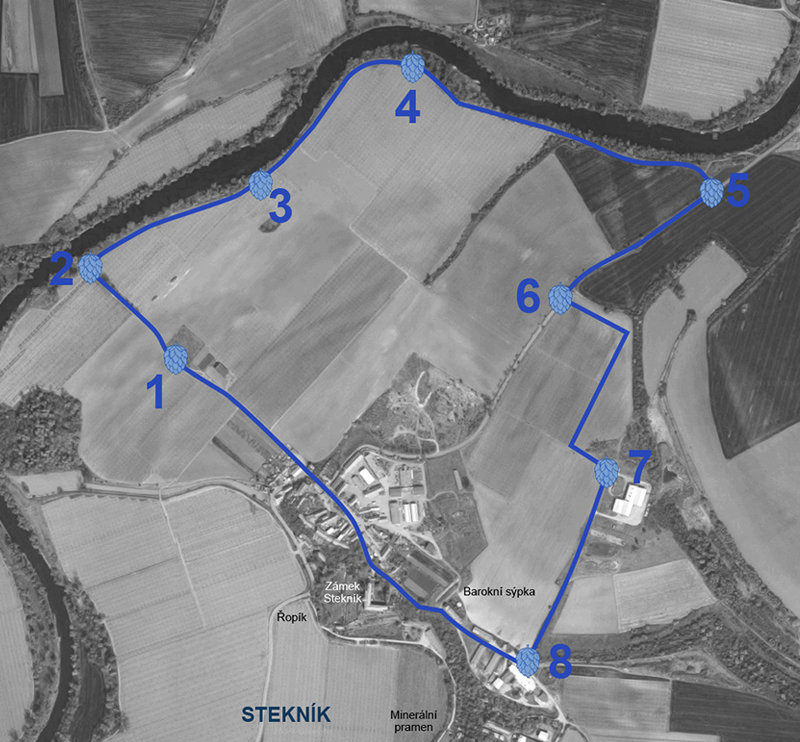HOP TRAIL POINTS
5. Hop gardens in the landscape
Exposed or improperly placed hop gardens intensify soil erosion. Genetically uniform culture of hops (these are female cones) succumb to pests much easier than wild ones, sexually reproducing varieties. Possible solutions are bio- hop gardens, of which our 4 hectares are yet negligible.
5. Hop gardens in the landscape
Hop gardens are often maintained by plow, so they are similarly endangered by wind and water erosion as other field cultures. Compared to, for example, the cornfield, the sloping hop field may be even more vulnerable, especially in intensive farming. The lower spraying frequency of conventional hop gardens is less burdensome for the environment than the average grain field, yet, for example, in Žatec area, water erosion of hop gardens is probably a significant phenomenon, though not well explored.
Hop cultures, like other monoculture plants, are very easily infected by “pests”. Among the most common ones are hop mite or hop aphid, hops are often also infected by different types of fungi and viruses. The spread of infection is also greatly enhanced by the clonal origin of the hops – genetically identical individuals often grow on one hop garden, making it easier to infect. In contrast, wild populations are significantly more resistant, as each individual is genetically “original” and responds to infection or attack differently.
The susceptibility of hop cultures and the intensive use of agro-chemistry is often a vicious circle, leading to further soil degradation and erosion. One of the solutions is the creation of bio-hop-gardens: the use of synthetic chemistry is very limited here: bio-hop-gardens use ecological links in the wild by intentionally supporting natural hop enemies “pests” who are able to protect the culture to a certain extent. The undergrowth of annual weeds on the lower floor of the hop garden then effectively prevents wind and water erosion. In our country, the bio-hop-garden is low – about 4 hectares, two of which can be seen here. However, beyond the borders of the Czech Republic, the biological cultivation of hops is more frequent and the area of bio-hop gardens is considerably higher.
Remarks:
The light fortification “řopík”, the hop neighbor in Žatec area. The Poohří area is not only a vital environment for hops, but in the past it was also of strategic importance as an important line of defense of our state. The deteriorating foreign-political situation in which Czechoslovakia found itself during the 1930s required the construction of a border line of light fortification, the so-called “řopík” – small concrete bunkers with heavy machine guns. Each “řopík” was supposed to cover the surrounding neighborhoods, according to the layout of the terrain, several tens to hundreds of meters distant bunkers, and together with a system of obstacles (barbed wire, ditches, steel and concrete obstacles) to create an impenetrable zone for infantry and tanks. An interesting example of the sophisticated use of all the defensive advantages provided not only by the bends and shores of the Ohře River, but also by the surrounding settlement is the C-14/68 building, situated in the corner of the Stekník Castle garden.
Have you not visited the hop path yet?
So you can take a stroll and read interesting facts about hops and the place.
You are entering the grounds of the Hop Institute, where agricultural machinery moves all year around. Take extra care! Enter at your own risk.


OPERATOR OF HOP TRAIL
 | Hop Research Institute Co., LTD Kadanska 2525 438 01 Zatec |
 | www.chizatec.cz |
 | +420 415 732 111 |
 | info@chizatec.cz |
HOP TRAIL | |
 | Stekník, 438 01 Žatec |
DOČESNÁ - DEGUSTACE PIV
Beer tasting during the beer festival at the Hop Research Institute in Žatec.
-traditional event for invited experts and laics at the Hop Research Institute
-accompanying program at the beer festival













